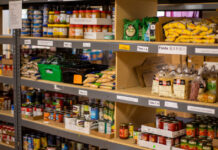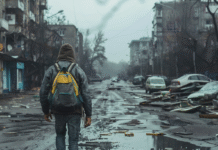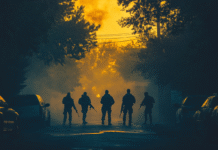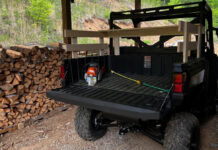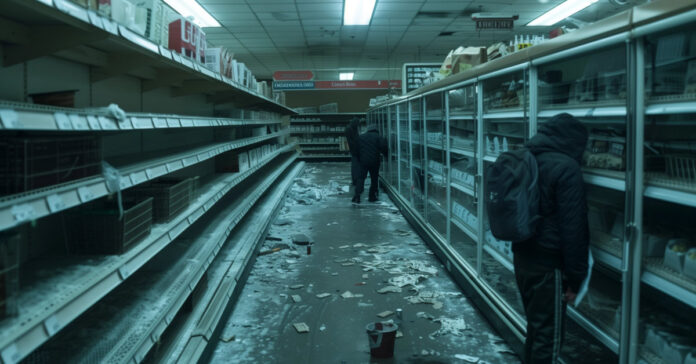
Even beginning preppers know the importance of what I call the big three: food, water, and shelter. Something I just read, however, is making me re-emphasize the importance of food. The report reviewed historical reports of mass starvation in the 20th Century, from the Holomodor in Ukraine in 1932-1933, to the Jews in the Warsaw Ghetto during WWII, to the Great Chinese Famine brought on by Mao’s policies in the late 1950s. The report projects that we would see similar starvation in a long-term grid-down scenario because of a lack of electricity and subsequent failure of interstate trucking.
I was not unaware of these famines; I mentioned both in a 2022 post about the problems with socialism. However, I had never stopped to think a collapse of the electric grid would lead to that kind of starvation here in the U.S. I mean, we have amber waves of grain and a chicken in every pot, right? I considered mass starvation to more likely be a side effect of a nuclear attack thanks to nuclear winter.
Plus, hunger makes people do terrible things, and in a world without the rule of law (WROL), terrible things—like killing someone over a can of beans—will become frighteningly commonplace.
While I had considered that people will get desperate when confronted with a lack of food, I probably underestimated how brutal and ugly things can get when everyone is desperate. The report drove home that point by illustrating what people did when faced with starvation, including not only violence but eating corpses and killing their own children.
By relaying this information to you, I hope you will reconsider the importance of food storage. Like me, you may decide to add more food to your long-term food storage program.
No Electricity = No More Food
The sudden lack of a way to harvest, process, preserve, and distribute food after the grid goes down is a key reason report after government report projects a 90 percent loss of life within a year after an EMP attack. Yes, there will be murder, disease, illness, radiation poisoning from nuclear power plants melting down, and death from exposure, but those who do not die in the first 60 days will likely starve to death before the year is out.
A 90 percent die-off means at least 300 million dead people in the U.S. and 35 million or so left alive. The last time the U.S. population was 35 million, we were in the middle of the Civil War. When I have previously said a grid-down scenario would knock us back to the 1880s on a technology level, I didn’t realize it would also be true for the population level.
Even if things go remarkably well and only 75 percent of the population dies, that’s still 250 million dead and just 80 million left alive. That’s the same population we had in 1902.
The report I am referring to is the Grid Down Report by Jonathan Hollerman, a former Air Force S.E.R.E. instructor, an EMP expert, Deputy Director of the US Task Force on National and Homeland Security, and a survival retreat consultant to high net worth individuals. (You can see his full bio here.) He points out that everyone from preppers to emergency response personnel to politicians and military leaders are underestimating the dangers we would face after an EMP strike or other catastrophic attack that brings down the grid for a period of more than two weeks. Not only will this cause panic and chaos among the populace, it will cause our nuclear plants to melt down.
Think About It
Hollerman simply says the quiet part out loud. He explains why no food on store shelves will lead to desperate people, while the absence of law enforcement will allow desperate people to do whatever they want with no official consequences. But he takes this farther than looting and bad behavior with a glimpse into the dog-eat-dog world that he expects will result, especially in large urban areas where there is high population density. Here’s a quote from the report:
“Without question, the most devastating effect a national grid-down event would have on the US population would be the destruction of the food distribution, followed closely by the loss of interstate trucking. Many aspects of a nationwide grid-down event are debatable. Which electronic will, or will not, be harmed is debatable. Which percentage of cars will, or will not, run is debatable. What is not debatable: it will be fundamentally impossible to feed 320 million Americans spread out over 3.8 million square miles without electricity and interstate trucking. It cannot happen. You will not be able to feed a single major metropolitan city without electricity.”
There are preppers out there that have a substantial supply of food. The question they must face is, can they keep it? I expect that will require some behavior that under our current societal norms might seem to be “bad,” such as shooting someone at the first sign of aggression. Today, we are counseled to de-escalate situations to retreat if we can, and to meet force only with equal force. In an uglier tomorrow filled with desperate people, you might have to jump from verbal threat to lethal force. There might be a period of time when anyone you don’t know is considered an enemy and even those you know are questionable.
You Can’t Reason with the Unreasonable
A lawyer who sometimes represented people committed to psychiatric hospitals against their will told me, “You can’t reason with the unreasonable.” He had seen it first hand while trying to deal with clients who were severely mentally ill. When hunger reaches the point that people fight over a single kernel of corn or eat mud and bark, don’t expect to reason with them. Harsh words, threats, or even warning shots may not dissuade them. If someone that desperate reaches your prepper hideout looking for food, you or someone on overwatch must be prepared to kill them when their desperation or unreasonableness manifests as aggression.
When the time comes to transitioning from prepping to survival, you will need to be your own law enforcement. You will have to enforce your rules and see to the safety of yourself and others in your family or group. To do so, you will not only need bullets, you will need intestinal fortitude. You will need the ability to justify to yourself and others what you had to do to protect your family and your food, and then compartmentalize it so your actions don’t keep you awake at night. Don’t expect it to be easy, but expect it to be necessary.
The Threat is Other People
The best way to increase your chance of survival is to minimize the number of people you come in contact with in the first months or eyar after a grid-down SHTF event. Your best bet is to be far from the city on the day the power goes out. Failing that, you need to have someone in a remote location waiting for you and the ability to get there in the first 48 hours.
Unknown people—strangers, if you will—are a threat, but people who know you and know you have a food storage program may be an even greater threat, especially if they tell others. You will need to come up with a plan on how to treat them. Do you give them a care package and send them on their way, thereby encouraging them and others to seek more handouts from you? Do you sit them down and feed them a bowl of rice with a few beans and tell them you are almost out of food? Will you put them to work in exchange for a meal? Or do you refuse to give them food, creating a potential enemy? Perhaps you will choose to post signs saying “Anyone who crosses this point will be shot” and then shoot them, regardless of whether you recognize them.
Food Scarcity
I’ve said it before: food is the foundation of your prepping program. For majority of Americans, water is naturally available. It may need to be purified, but unless you live in a desert, it’s out there. Most of us also have a place to live. If there is a big die off, there will be empty homes dotting the landscape in just months. Food, however, is going to be hard to find because it spoils. Even when it grows in the wild, most people don’t know how to recognize it.
Have you seen how fast the milk, bread and water shelves at the grocery store or Walmart empty out when there is the threat of a blizzard or hurricane? Now picture every aisle empty after a wave of panicked shoppers, followed two days later by a wave of desperate looters. I don’t expect someone in a blue vest is going to stop an angry horde. I expect they’ll get first choice.
Do you know where the warehouse is that serves the local grocery store? Do you know where the Walmart, CVS or Dollar General trucks come from? If not, you can believe someone else does. They are either going to loot it or capture and hold it to prevent others from looting it. (I can think of worse places to spend the first several months of a grid-down disaster than in a warehouse loaded with non-perishable goods.)
After the stores and warehouses, the hungry hordes will turn to the stalled trucks and trains. Eventually, people will go door-to-door in residential areas, breaking in when necessary, while others search businesses. At some point, even a vending machine with chips, candy bars, and Little Debbie donuts will be worth fighting over. Eventually, there will be no food left to find.
Food as Currency
There are stacks of grain in silos and pallets of food in warehouses all across the country. That food will be here when the power goes out, but it will never be replenished. Whoever is smart enough to take control of these resources and hold them in the face of the hungry hordes will grow powerful.
Food will become a currency, and for a time it will be more valuable than gold. Women will sell themselves and the desperate will sell their children for food. Men will join a gang or a warlord and fight and kill rivals for the promise of food.
I suspect we will see a reemergence of feudal society where the local warlord or “noble” has an armed force to protect himself, his territory, and his property, which will include peasants. The smartest of these new warlords will start farming operations. The people who survive yet have no fighting or other useful post-SHTF skills will become the equivalent of their peasants and work the farm by hand. It will be that or starve, and many will starve regardless, because the warlord will take most of the harvest.
The warlords who don’t start a far will become roving bands looking to loot preppers and other warlords.
Grid Down Report
I should credit the Canadian Prepper’s YouTube channel for introducing me to Hollerman and his report. I have linked at the end of this post to two videos featuring Hollerman and CP discussing various aspects of surviving after an EMP or other grid-down event. These are two of his better videos, and I watched them all the way through. (That’s not always the case. If Nate’s predictions all came true, we’d be dead a few dozen times over.)
This is not to say I agree with everything Hollerman says, but I agree with his general premise. (Read the report and make your own decision.) It has increased my awareness of the potential effects of starvation after a global or national SHTF event. I also agree that people are the biggest threat and that there will be far more acts of brutality and violence than many expect. That is one reason I live in the middle of nowhere.
Long-Term Storage Options
Even though I have food stored that will last us multiple years plus chickens, bees, a garden, and access to wild apples, berries and other native foods, I plan to increase the amount of long-term storage food in my preparedness program. I’m going to do that by packing grains and beans in 5-gallon buckets and buying select #10 cans. This will be instead of continuing to expand my prepper pantry of canned and other grocery foods.
I will avoid expensive freeze-dried foods and count on boring but filling foods such as hard red wheat, oatmeal, rice, pasta, pinto beans, black beans, split peas, lentils, peanut butter powder, pancake mix, and some corn meal. I can shop over a period of months, spreading out the cost, buying rice, beans, and oatmeal at Sam’s Club, wheat from Azure Standard, and pasta at Walmart. If I buy and seal two buckets a month, I will have 16 buckets by the end of the year and 40 by the end of 2025.
Because I am paying for our solar power system, my budget for food storage is limited. I will start with rice and pinto beans, which are cheap, followed by pasta. The wheat will have to wait until next year.
If you want to prepare your own buckets of dried foods, I recommend Sorbent Systems for Mylar bags and oxygen absorbers. If you want to buy food already in buckets or in #10 cans, I recommend Rainy Day Foods. I’ve dealt with both since before Y2K.
Video of the Day
Following are the two videos featuring Hollerman I referenced above. The first is more general while second one gets into more details related to starvation. Both are worth watching.

